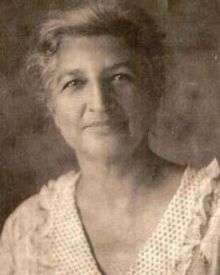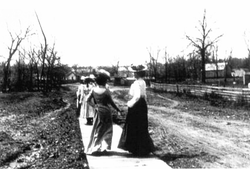Jennie Ross Cobb
Jennie Ross Cobb (Cherokee, 1881–1959) is the first known Native American woman photographer in the United States, who began taking pictures of her Cherokee community in the late 19th century. The Oklahoma Historical Society used her photos of the Murrell Home to restore that building, which is now a museum. Trained as a teacher, Cobb worked as a florist in Texas before returning to Oklahoma to spearhead the restoration of the Murrell Home.
Jennie Ross Cobb | |
|---|---|
 | |
| Born | Jennie Fields Ross December 26, 1881 |
| Died | January 19, 1959 (aged 77) |
| Nationality | American, Cherokee Nation |
| Education | self-taught |
| Known for | Native American photography |
Early life
Jennie Fields Ross was born on December 26, 1881[1] in Tahlequah, Cherokee Nation, Indian Territory to Fannie D. (née Thornton) and Robert Bruce Ross. She was named after her father's mother, Jennie Fields[2] and was a great-granddaughter of Cherokee Chief John Ross.[3] Her father was treasurer of the Cherokee National Council and served in other tribal administration capacities,[4] as well as farming on the Ross homestead near Park Hill.[5]
During her teenage years, Ross spent much time among the various Ross relatives in Park Hill. The family lived in the "Hunter's Home," now known as the Murrell Home, and Jennie, an amateur photographer, took photographs of the house, surrounding areas[6] and her school mates.[7] She began taking pictures around 1896 and continued until around 1903,[8] developing her photographs in a closet at the Murrell Home.[6] The images "defied the stereotypical photographic views" of Native Americans at the time, showing that the Cherokee were educated, fashionable, and proud of their culture.[7] Ross attended school at the Cherokee Female Seminary, which had been rebuilt in 1889[9] and may have graduated in 1900[10] or 1902.[8]
Career

After completing her own studies, Ross became a teacher[8] at the Cherokee school in Paw Paw.[11] She married Jesse Clifton "J. C." Cobb[12] in 1905 and they subsequently had one child, a daughter named Jenevieve in 1906.[13]
In 1928, the family moved to Arlington, Texas and by the early 1930s, Cobb was running a floral shop business called the Flower Market.[13][14][15] J.C. was an engineer in the oil business.[16] After his death in 1940,[17] she and Jenevieve worked together in the florist shop.[13] Cobb was involved with the rose garden in Arlington's Meadowbrook Park. She and Jenevieve worked with the Arlington Garden Club to help them win an award from Woman's Home Companion in a contest.[18] Jenevieve died on August 8, 1945 in Arlington[19] and Cobb took her two grandchildren, Jennifer and Cliff Biggers, to raise.[18]
In 1952, Cobb left Arlington[18] and returned to Oklahoma to help restore the Murrell Home. Armed with her photographs from the turn of the century and her memories, Cobb assisted restoration experts to creating a more accurate version of the home. Pilings which indicated a wrap-around porch had once been there were shown to be a later addition and not restored. She supervised gathering furnishings and artifacts from Ross family members and other Cherokee families, overseeing the opening of the museum.[6]
Death and legacy
Cobb died from a heart attack on January 19, 1959 at a hospital in Tahlequah[3] and was buried beside her husband and daughter at Rose Hill Cemetery in Arlington, Texas.[18]
Cobb is often credited with being the first, first woman, or one of the first, Native American photographers in the United States.[20][21][22] The Oklahoma Historical Society maintains the Jennie Ross Cobb Collection of photographs, which has toured in several exhibitions through the years, such as the 1995 Photographers in Petticoats: Oklahoma Territories 1890-1907 exhibition at the Pioneer Woman Museum in Ponca City[13][23] and a traveling exhibition called Our People, Our Land, Our Images: International Indigenous Photography, curated by Hulleah J. Tsinhnahjinnie (Diné/Muscogee/Seminole) and Veronica Passalacqua, which has toured the country since 2007.[21][22] The University of Oklahoma Libraries' Western History Collections also has a collection of her documents relating to the restoration of the Murrell Home and other Ross family memorabilia.[24]
References
Citations
- Dawes Rolls 1906.
- The Chronicles of Oklahoma 1930, p. 355.
- The Daily Oklahoman 1959, p. 37.
- The Chronicles of Oklahoma 1930, p. 356.
- The Chronicles of Oklahoma 1930, p. 357.
- Ridge 2008.
- Jensen 1998.
- Till 1994, p. 54.
- Starr 1921, p. 235.
- Starr 1921, p. 237.
- Mihesuah 1997, p. 120.
- Maddox 2005, p. 217.
- Till 1994, p. 55.
- The Arlington Colt 1934, p. 2.
- The Arlington Colt 1935, p. 4.
- U. S. Census 1930, p. 18B.
- U. S. Census 1940, p. 11B.
- The Daily News Texan 1959, p. 3.
- Texas State Board of Health 1945.
- Claviez & Moss 2000, p. 265.
- McDonnell 2014.
- Biles 2013.
- NewsOK 1995.
- Western History Collections 2016.
Bibliography
- Biles, Jan (February 2, 2013). "Flint Hills Discovery Center focuses on indigenous photography". The Topeka Capital-Journal. Topeka, Kansas. Retrieved 13 August 2016.CS1 maint: ref=harv (link)
- Claviez, Thomas; Moss, Maria (2000). Mirror Writing: (re-)constructions of Native American Identity. Berlin, German: Galda & Wilch. ISBN 978-3-931397-25-8.CS1 maint: ref=harv (link)
- Jensen, Joan M. (1998). "Native American Women Photographers As Storytellers". College of Liberal Arts Purdue. West Lafayette, Indiana: Purdue University. Archived from the original on July 5, 2005. Retrieved 13 August 2016.CS1 maint: ref=harv (link)
- Maddox, Jerry A. (2005). From Salacoa to Tahlequah: Plantation in the Valley The Martin-Erwin House. Bloomington, Indiana: AuthorHouse. ISBN 978-1-4634-7237-5.CS1 maint: ref=harv (link)
- McDonnell, Brandy (April 11, 2014). "Interviews: Indigenous photography exhibit "Our People, Our Land, Our Images" opens TODAY at Fred Jones Jr. Museum of Art". Oklahoma City, Oklahoma: NewsOK. Retrieved 13 August 2016.CS1 maint: ref=harv (link)
- Mihesuah, Devon A. (1997). Cultivating the Rosebuds: The Education of Women at the Cherokee Female Seminary, 1851-1909. Urbana, Illinois: University of Illinois Press. ISBN 978-0-252-06677-1.CS1 maint: ref=harv (link)
- Ridge, Betty (December 9, 2008). "Murrell Home to celebrate 60 years". Tahlequah, Oklahoma: The Tahlequah Daily Press. Retrieved 13 August 2016.CS1 maint: ref=harv (link)
- Starr, Emmet (1921). History of the Cherokee Indians and Their Legends and Folk Lore. Oklahoma City, Oklahoma: Warden Company. OCLC 2702462.CS1 maint: ref=harv (link)
- Till, Jennifer E. (1994). Seven Female Photographers of the Oklahoma and Indian Territories, 1889 to 1907 (PDF) (B.A.). College Park, Maryland: University of Maryland. Archived from the original on 2016-08-13.CS1 maint: ref=harv (link) CS1 maint: BOT: original-url status unknown (link)
- "1930 U.S. Federal Census: Arlington, Texas". FamilySearch. Washington, D. C.: National Archives and Records Administration. April 14, 1930. Retrieved 13 August 2016.
- "1940 U.S. Federal Census: Arlington, Texas". FamilySearch. Washington, D. C.: National Archives and Records Administration. April 14, 1940. Retrieved 13 August 2016.
- "Anne Ross Piburn Collection". University of Oklahoma Libraries. Norman, Oklahoma: Western History Collections. 2016. Retrieved 13 August 2016.
- "Cobb-Allen Flower Market". Arlington, Texas: 'The Arlington Colt. December 20, 1934. Retrieved 13 August 2016 – via Newspaperarchive.com.

- "Curator Dies at Tahlequah". Oklahoma City, Oklahoma: The Daily Oklahoman. January 21, 1959. Retrieved 13 August 2016 – via Newspaperarchive.com.

- "Long Time Resident Here Dies". Arlington, Texas: The Daily News Texan. January 21, 1959. Retrieved 13 August 2016 – via Newspaperarchive.com.

- "Necrology". Chronicles of Oklahoma. Oklahoma City, Oklahoma: Oklahoma Historical Society. 8 (3): 355–356. September 1930. ISSN 0009-6024. Archived from the original on 27 January 2003. Retrieved 13 August 2016.
- "State Artists Shown at Gallery". Oklahoma City, Oklahoma: NewsOK. May 19, 1995. Retrieved 13 August 2016.
- Texas Death Certificates, 1890-1976: Jenevieve Biggers (Report). Austin, Texas: Texas State Board of Health. August 8, 1945.
- The Final Rolls of the Citizens and Freedmen of the Five Civilized Tribes in Indian Territory: Jennie F. Ross (Report). Washington, D.C.: National Archives and Records Administration. 1906. Card #6838, Roll #16357.
- "The Flower Market". Arlington, Texas: 'The Arlington Colt. April 11, 1935. Retrieved 13 August 2016 – via Newspaperarchive.com.
